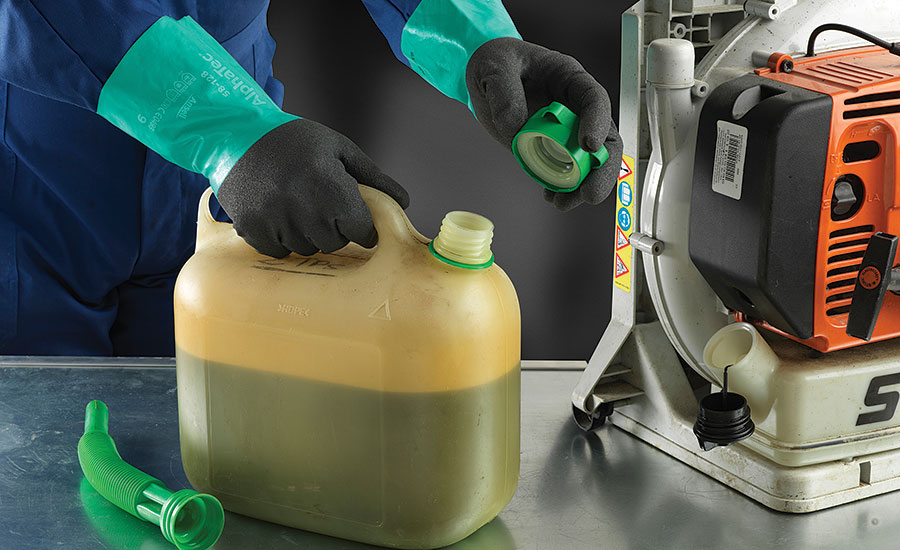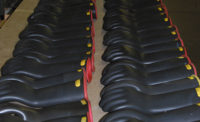It’s impossible to know exactly how many chemicals exist in the world, but more than 60 million are registered with Chemical Abstracts Service system. About 80,000 are in use regularly worldwide, and that doesn’t count all the combinations of those chemicals. These are overwhelming numbers, and the challenge of protecting workers against this massive universe can seem just as overwhelming.
The sheer volume isn’t the only issue. Various chemicals and chemical compounds react in different ways to different materials used in gloves. Nitrile is effective against lubricating oils but not acetone, which is used to remove paint or nail polish. Neoprene is a good fit against many pharmaceutical agents, but ineffective against methylene chloride, another common paint-remover. In addition, there are chemical mixes that add increased complexity and require a chemist to identify the right protection.
The same variation is true of reactions to chemicals on the skin. Some you can see—irritation, rashes, or far more serious chemical burns. In 2014, there were 33,600 reported incidences of recordable occupational skin diseases, carrying an estimated price tag of $1 billion in the U.S. alone. Others aren’t as obvious, but can be significantly more dangerous—certain chemicals absorbed through the skin can attack the nervous system, reach the bloodstream and do organ damage.
Clearly, protecting workers exposed to chemicals is critical, but complicated. Making the right choice for hand protection requires knowledge of the types of chemicals in the workplace and an understanding of which gloves—or combinations of gloves (we’ll get to that)—are effective against those chemicals.
Common challenges in complex environments
Chemicals are everywhere, used in every industry. Whether it’s paint used in automotive manufacturing, chemicals used in pharmaceuticals or manufacturing of beauty products, pesticides, fertilizers, rubber and plastic formulation or simply chemicals used for cleaning virtually anything, chemicals are there. Regulations are robust when it comes to handling chemicals. Wherever workers come in contact with chemicals, they are going to be required to wear hand protection.
There are fundamental challenges—and truths—that are consistent whenever and wherever workers are required to wear gloves. Workers want three things from their gloves—comfort, performance and protection, probably in that order. Fail on the first two—if gloves are uncomfortable or make it difficult to do the job—and the worker will remove the gloves or find an alternative, even if that alternative doesn’t provide the necessary protection. This is true even in environments where chemicals are present, and to ignore this truth is to invite non-compliance.
Chemical gloves are evaluated on three characteristics:
(1) Penetration—Simply put, if you pour water in the glove, how much makes it through?
(2) Permeation—Can a chemical, over time, work its way through? Think about helium escaping a balloon.
(3) Degradation—Do the chemicals break down the materials in the glove over time?
The impact of chemical penetration in terms of comfort and performance is fairly obvious—why bother with gloves at all if your hands are still getting wet?—as is degradation—no one wants to wear a glove that’s falling apart. But permeability is a critical consideration when it comes to protection. Chemical gloves, by definition, must prevent chemicals from reaching the skin. But that works both ways. Some non-permeable gloves can be hot, sweaty and uncomfortable, leading workers to pull them off frequently or use a different type of glove that’s more breathable but doesn’t protect the hands the way it should.
Even in tightly regulated environments where chemicals are common, non-compliance trumps glove performance as the biggest obstacle to worker safety. Consider this: Across industries, 43 percent of workers don’t know if the gloves they wear adequately protect their hands, according to one study. That’s outrageous.
Understanding the options
Clearly, education and awareness are lacking, and that’s compounded when dealing with millions of chemicals and various materials used that protect against them. Informed workers do not have to choose between comfort, performance or protection. Through new technologies, materials and creative approaches, glove manufacturers are finding ways to address the many needs of the worker while not compromising protection from potentially dangerous chemicals.
New technologies are leading to significant improvements in moisture management, either with the glove itself or in combination with a liner. These gloves improve grip, even in wet, oily conditions, and better manage sweat to keep the hands dry and comfortable. Double-donning remains a viable option in some cases—wearing a cut-protection glove under a chemical glove, or a thermal management glove under or over a chemical glove. But some gloves are designed to protect against chemicals while also providing abrasion and puncture resistance—deployed appropriately from fingertip to palm, all the way up the sleeve.
Knowledge is the key to ensuring workers are not only protected, but equipped with the best tools for their jobs.



